Recent advances in aggregation-induced emission materials for enhancing solar energy utilization
Haixiang
Liu
a,
Haotian
Bai
 b,
Jacky W. Y.
Lam
ab,
Ryan T. K.
Kwok
ab and
Ben Zhong
Tang
b,
Jacky W. Y.
Lam
ab,
Ryan T. K.
Kwok
ab and
Ben Zhong
Tang
 *abc
*abc
aHKUST-Shenzhen Research Institute, No. 9 Yuexing 1st RD, South Area, Hi-tech Park, Nanshan, Shenzhen 518057, China
bThe Hong Kong Branch of Chinese National Engineering Research Center for Tissue Restoration and Reconstruction, Department of Chemistry, The Hong Kong University of Science and Technology, Clear Water Bay, Kowloon, Hong Kong 999077, China
cSchool of Science and Engineering, Shenzhen Institute of Aggregate Science and Technology, The Chinese University of Hong Kong, Shenzhen, Guangdong 518172, China. E-mail: tangbenz@cuhk.edu.cn
First published on 2nd February 2023
Abstract
Aggregation-induced emission (AIE) materials possessing unique properties in both the solution state and the aggregate state in the aspects of absorption, photoluminescence and heat generation have been well-established for wide applications in the past two decades. In recent years, several emerging applications of AIE materials in solar energy utilization, including luminescent solar concentrators, photosynthesis augmentation and solar steam generation have been reported. This mini-review provides a concise summary of these AIE materials in these aspects.
Introduction
The global issues of energy shortage and global warming compel us to find clean energy that is sustainable and “carbon neutral”.1 Solar energy has been regarded as a major clean and renewable energy, and the correlational investigation and utilization studies have been developed over the past decades.2 Tremendous research efforts have been devoted to photovoltaics that convert solar energy into electricity,3 photosynthesis that stores solar energy as chemical energy,4 and photothermal devices that convert solar energy into heat.5 The utilization of solar energy still faces some challenges such as limited sunlight collection, unpredictable weather conditions, and the usage of a limited part of the solar radiation spectrum (300–2500 nm).6 Organic functional materials have been utilized in increasing solar energy utilization such as organic solar cells, luminescent solar concentrators (LSCs),7 artificial photosynthesis,8 and solar steam generation.9 Aggregation-induced emission luminogens (AIEgens) are a group of molecules that are not emissive in the solution state but are highly emissive in the aggregate state.10,11 The active intramolecular motion of AIEgens in the solution state relaxes the excitation energy into heat while in the aggregate state, the restriction of intramolecular motion by confinement activates the radiative decay. Numerous AIEgens have been synthesized according to this working mechanism. They have been widely applied in organic light emitting diodes,12 fluorescent sensing,13 biomedical imaging14 and solar cells,15–17 which have been well summarized in previous reviews.18–22 In this minireview, we summarized the recent progress of AIEgens in the field of solar energy utilization. In order to make a concise summary, we mainly focused on the LSCs, photosynthesis augmentation and solar steam generation. In these applications, the efficient luminescence in the aggregate state and heat generation in the solution state were utilized. The molecular structures of the AIEgens in this minireview are summarized in Chart 1 numbered from 1 to 15. In the meantime, we have also provided a perspective on the future development.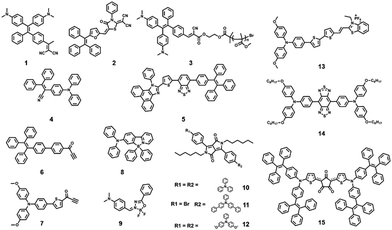 | ||
| Chart 1 Molecular structures of AIEgens utilized in luminescent solar concentrators (1–5), photosynthesis augmentation (6–12) and solar steam generation (13–15). | ||
LSCs using AIEgens
A LSC is a simple device that utilizes optical polymers or glasses that are attached or doped with luminescent materials to collect light for photovoltaic cells to generate electricity. The photons in the LSC are concentrated on the edge via fluorescence emission, diffraction and total internal reflection.23 LSCs increase the photon utilization of oblique angles and short wavelengths. One of the most promising applications of LSCs is building-integrated photovoltaics (BIPV) which allow both lighting and electricity generation.24 However, the photon-to-electron conversion efficiency is not high enough. Several improvements have been explored over the years including the design of novel fluorophores with high quantum yields and a large Stokes shift and limited photon loss on the surface and internally.25 The emitted photons might be reabsorbed by the fluorophores due to the overlapping of the excitation and emission spectra, and lead to energy loss by multiple reabsorption. A large Stokes shift means that the excitation and emission wavelengths are well separated, thus reducing the reabsorption of the luminophores inside LSCs. AIEgens possess efficient fluorescence in the aggregate state and a large Stokes shift. And they are promising candidates in the construction of LSCs.26A common way of evaluating the performance of a LSC is the optical efficiency. Experimentally, the optical efficiency of a LSC is defined as the fraction of incident solar power that reaches the edges of the device. Optical efficiency is influenced by the geometric factor G where G is the ratio between the surface exposed to the solar radiation and the area of the edges (G = Atop/Aedge). The optical efficiency is determined by the ratio of the short circuit current measured for the LSC (ILSC) and the product of the short circuit current of the PV cell when perpendicular to the light source (ISC) multiplying G. The power conversion efficiency (PCE) of LSC (PLSC) can be eventually calculated by the product of optical efficiency multiplying the PCE of the PV cell.26
Pucci and co-workers utilized a red-emitting AIEgen TPE-AC (1) to construct LSCs using optical polymetric thin films including poly(methyl methacrylate) (PMMA) and polycarbonate (PC).27 TPE-AC had a broad absorption in the range of 400–550 nm and an emission peak at 600–620 nm, and it enjoyed a high quantum yield of 50% when it was doped in PMMA and PC matrices (0.1–1.5 wt%). The high quantum yield endowed an optical efficiency of 6.7% for the PC-doped systems attached on a 50 × 50 × 3 mm optically pure glass substrate (Fig. 1a).
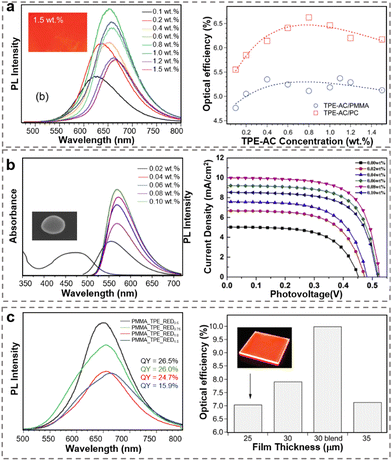 | ||
| Fig. 1 LSC using an AIEgen. (a) The photoluminescence (left) and optical efficiency (right) of a LSC doped with small molecular AIEgen TPE-AC, (b) the absorption and emission spectra (left) and photocurrent generation (right) of LSC doped with AIE microparticles TPFE-Rho and (c) the photoluminescence (left) and optical efficiency (right) of an LSC composed of an AIE initiated polymer. Figures were adapted and reproduced with permission: (a) ref. 20 Copyright 2017, The Royal Society of Chemistry and the Chinese Chemical Society; (b) ref. 21 Copyright 2019, Elsevier; (c) ref. 22 Copyright 2018, The Royal Society of Chemistry. | ||
Gong and co-workers also utilized AIEgens in LSC construction for BIPH.28 They used AIEgen TPFE-Rho (2) and PMMA to construct LSC. The constructed LSC showed an absorption between 450 and 500 nm and a fluorescence between 550 and 650 nm. The photovoltaic performance was collected to show that PLSC was increased within the range of TPFE-Rho concentration in 0.1 to 0.8 wt%. The highest PLSC (1.8 × 1.8 × 0.5 cm) was reported as 3.55% (Fig. 1b).
The doping of AIEgens in LSC is not uniform, which might decrease the optical efficiency. To achieve a better distribution, Pucci and co-workers have established another method to construct LSCs.29 They utilized AIEgen TPE_RED (3) as an initiator to prepare red-emitting PMMA polymers. TPE_RED was a derivative of TPE-AC, and it contained a 2-bromo-2-methylpropanoate unit that could initiate the polymerization of methyl methacrylate (MMA). The PMMA polymer containing 0.98–3.05 wt% of TPE_RED showed an absorption in the range of 400–600 nm, and an emission in 610–650 nm. The maximum quantum yield reached 26.5% when 0.5% wt% TPE_RED was used in polymer preparation. The LSC made from an AIE polymer attached on a 50 × 50 × 3 mm optically pure glass substrate showed a maximum optical efficiency of 7.05%, which was higher than the doped films containing the same concentration of its monomer. This was possibly due to the better homogeneity of the fluorophores inside the LSC. Furthermore, the blended LSC of PMMA/PMMA-TPE_RED, which included high molecular weight PMMA that further restricted the molecular motion of AIEgen, showed an optical efficiency of up to 10% (Fig. 1c).
Apart from doping one AIEgen in the LSC, Wong and co-workers reported a LSC by using a pair of AIEgens as the energy donor and acceptor.30 The energy transfer between two AIEgens doped in the LSC could reduce the reabsorption and thus increase the optical efficiency (Fig. 2a). The DPATPAN (4) was the energy donor while the PITBT-TPE (5) was utilized as the acceptor. The emission spectrum of DPATPAN overlapped well with the absorption spectrum of PITBT-TPE, while the emission spectrum of PITBT-TPE was far from the absorption of DPATPAN (Fig. 2b). The quantum yield of DPATPAN was very high (about 98%) and kept stable even at 250 mM, while the quantum yield of PITBT-TPE decreased from 93% at 9 mM to 45% at 225 mM. LSCs constructed from 250 mM DPATPAN or 250 mM DPATPAN/22.5 mM PITBT-TPE in a PMMA film attached on a 1.25 × 1.25 × 0.1 cm glass substrate were investigated as comparison. The reabsorption value FR was lower while the optical efficiency was higher in the DPATPAN/PITBT-TPE system compared to the LSC with single AIEgen DPATPAN (Fig. 2c).
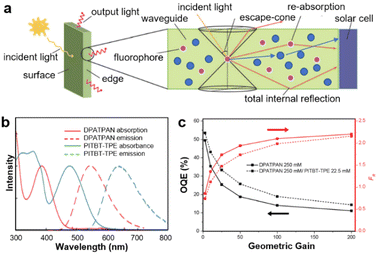 | ||
| Fig. 2 LSC based on energy transfer from AIEgen pair. (a) Schematic illustration of LSC composed of two AIEgens, (b) absorption and PL spectra of two AIEgens DPATPAN and PITBT-TPE and (c) optical quantum efficiency (OQE) and reabsorption rate (FR) of LSC composed of DPATPAN alone and DPATPAN/PITBT-TPE pair. Figures were adapted and reproduced with permission.23 Copyright 2018, The Royal Society of Chemistry and the Chinese Chemical Society. | ||
The utilization of several luminescent materials could also be achieved in the tandem design of LSCs. Gong and co-workers reported a tandem LSC that was composed of N-doped carbon dots (N-CDs) and TPFE-Rho (2).31 The absorption spectrum of a N-CDs/PVP thin film was 300–450 nm and the emission peak was around 430 nm, with a quantum yield of up to 34.88% (Fig. 3a) while the TPFE-Rho/PMMA thin film showed an absorption from 420 nm to 550 nm and an emission range between 550 and 650 nm, with a quantum yield of up to 79.65% (Fig. 3b). The tandem LSCs were made up of two layers of N-CDs/PVP and TPFE-Rho/PMMA thin films, which had a major absorption of UV/blue light in the first layer and blue/green light in the second layer (Fig. 3c). The tandem LSC had a PLSC of up to 4.06%, composed of 1.76% in the first layer (2.5 × 2.0 × 0.1 cm) and 2.30% in the second layer (2.5 × 2.0 × 0.2 cm) (Fig. 3d).
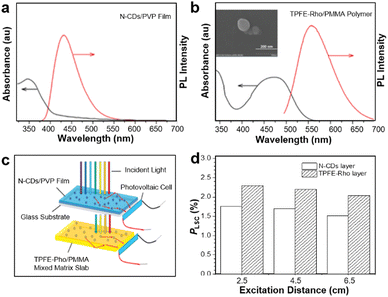 | ||
| Fig. 3 Tandem LSC using carbon dots and AIEgens. Absorption and PL spectra of (a) carbon dots and (b) AIEgen TPE-Rho, (c) schematic illustration of a tandem LSC and (d) the PLSC of different layers. Figures were adapted and reproduced with permission.24 Copyright 2019, The Royal Society of Chemistry. | ||
Photosynthesis augmentation using AIEgens
Fluorescent materials could be used to enhance the solar energy utilization of photosynthetic systems.32,33 Natural photosynthesis is performed in photosynthetic machineries including light harvesting pigments, light reaction systems and light-independent systems. In the process of photosynthesis, solar energy was first absorbed by photosynthetic pigments including chlorophyll, carotenoids and phycobilins. Then the absorbed energy is transferred to the reaction center and excites chlorophyll a. This will generate electron transport and produce adenosine triphosphate (ATP) and nicotinamide adenine dinucleotide phosphate (NADPH), which were then used to fix carbon dioxide into sugars in light-independent reactions.34 The photosynthetic pigments and their absorption spectrum are the key factors to the light utilization of photosynthesis. Chlorophylls mainly absorb blue and red light, while carotenoids mainly absorb yellow light.35 The spectral shift of fluorescent materials could convert harmful UV light which might destroy proteins and nucleic acids and inefficient light which cannot be absorbed by pigments, into highly efficient light. More energy absorbed in photosynthetic pigments results in increased electron generation and transport, increased production of ATP and NADPH and increased amount of carbon fixation.36Chloroplast is the basic photosynthetic unit of photosynthetic plants.37 Li and co-workers reported a hybrid photosynthetic system, composed of chloroplasts and AIE-active carbon dots (CD-AIEgens).38 The CD-AIEgens were made from natural quercetin by hydrothermal treatment, which showed a size between 3 and 5 nm in ethanol but increased to around 500 nm in water. The CD-AIEgens showed absorption in the UV region, while they emitted green and red fluorescence that could be absorbed by the chloroplasts. Compared to chloroplast alone, the chloroplast with CD-AIEgens showed increased photosynthetic electron transport rate and ATP generation (Fig. 4a).
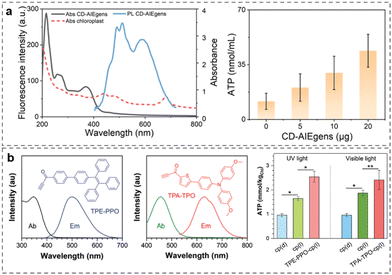 | ||
| Fig. 4 Photosynthesis augmentation of chloroplast by AIEgens. (a) Absorption and emission spectra of CD-AIEgens and chloroplast (left) and the increased ATP generation of chloroplast internalized of CD-AIEgens (right), (b) absorption and emission spectra of two AIEgens TPE-PPO (left) and TPA-TPO (middle), and the increased ATP generation of AIEgen conjugated chloroplast under UV and visible light. Figures were adapted and reproduced with permission: (a) ref. 31 Copyright 2021, American Chemical Society; (b) ref. 32 Copyright 2021, The Royal Society of Chemistry. | ||
Tang and co-workers also reported an AIE-chloroplast system by bioconjugation.39 They designed two AIEgens with activated alkyl groups, namely TPE-PPO (6) and TPA-TPO (7). These activated alkyl groups could react with amino groups on the surface of chloroplast via a metal free “click” reaction under mild conditions that did not affect the functions of chloroplast. TPE-PPO showed absorption between 300 and 400 nm in the UV region and emission in the region of photosynthetically active radiation. On the other hand, TPA-TPO mainly absorbed between 400 and 500 nm and emitted light between 600 and 700 nm that could be more efficiently utilized by chloroplasts. The AIE-chloroplast conjugates showed increased photosynthetic speed and ATP generation compared with chloroplast alone. The increment was about 54% of TPE–PPO–chloroplast under UV light and 33% of TPA–TPO–chloroplast under white light (Fig. 4b).
Microalgae are mainly photosynthetic single cells with a simple structure. They are widely used to provide third-generation biofuel, healthy food, and nutritional supplement.40,41 Thus, enhancing photosynthesis and growth of microalgae has attracted much attention. Tang and co-workers reported a boosted growth of cyanobacteria by the addition of AIEgens TPBA (8) and APO (9) into the growth medium of cyanobacteria Synechococcus bacillaris (CCMP 1333).42 TPBA and APO absorbed in the UV and blue regions, and emitted green and yellow fluorescence, with PLQY of 88.4 and 25% respectively. However, the green and yellow emissions could be more efficiently utilized by cyanobacteria. The addition of AIEgens in the culture medium formed stable nanoaggregates and kept around the cyanobacteria cells. The nanoaggregates formed from TPBA and APO enhanced the photosynthetic quantum yield and boosted the growth of cyanobacteria by about five-fold (Fig. 5a).
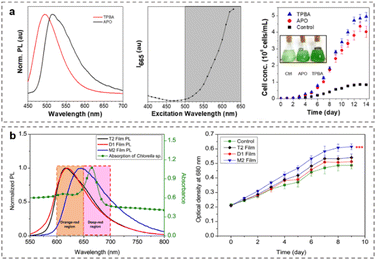 | ||
| Fig. 5 Photosynthesis and growth augmentation of microalgae by AIEgens. (a) PL spectra of AIEgens TPBA and APO (left), excitation spectra of cyanobacterial autofluorescence (middle) and cell density of cyanobacteria adding TPBA and APO (right); (b) PL spectra of AIEgen doped film and the absorption spectra of chloroplast (left), andoptical density of algae by applying AIEgen doped films (right). Figures were adapted and reproduced with permission: (a) ref. 35 Copyright 2021, American Chemical Society; (b) ref. 36 Copyright 2020, American Chemical Society. | ||
Kim and co-workers constructed light-converting fluorescent films using AIEgens to enhance the biomass and lipid productivity of green algae Chlorella sp.43 These AIEgens are composed of a diketopyrrolopyrrole (DPP) core and different donors of triphenylamine (TPA) moieties, named T2 (10), D1 (11) and M2 (12) respectively. These AIEgens showed absorption around 500 nm and emission in orange red (600–650 nm) and deep red (650–700 nm) which can be efficiently utilized by the green algae. Among them, M2 had the strongest donor unit and thus its emission peak was located in the deep red region. The growth and lipid production of the Chlorella sp. increased for the light-converting film. And the highest increment of 26% in cell density and 28.8% in fatty acid production was achieved by the M2 film (Fig. 5b).
Solar steam generation using AIEgens
Efficient solar steam generation, which converts solar energy into heat and vaporizes water, could be a promising source of clean water.44 An ideal photothermal converting structure should have high photothermal conversion efficiency, large surface to volume ratio, and porous and continuous water pumping.45 Fibrous materials have a large surface area and interconnected pores, and they are promising in photothermal applications including solar steam generation. However, it is difficult for several photothermal materials such as carbon black, to mix with fiber. On the contrary, organic materials have good solubility in organic solvents, exhibiting good compatibility with fiber. Among them, AIEgens are non-emissive in the solution state, turning adsorbed energy mainly into heat. The reason is that AIEgens usually have a lot of molecular rotors/vibrators and show a propeller-like structure. This could guide us in the use of intramolecular motions for solar steam generation.Tang and co-workers reported a three-dimensional all-fiber aerogel (3D AFA) doped with AIEgens.46 This aerogel could float on water and continuously generate heat to vaporize water under solar irradiation. The AIEgen MTTT-BT (13) showed obvious absorption between 300 and 750 nm with a peak at 560 nm. The aerogel was made of poly(vinylidene fluoride-co-hexafluoropropylene) (PVDF-HFP) doped with 5% of MTTT-BT. Different from the visible light absorption of MTT-BT, the 3D AFA exhibited a strong and broad light absorption in the whole spectrum of 200–2500 nm and efficient heat generation under solar irradiation. Taking advantage of the above, the 3D AFA showed a high evaporation rate of 1.43 kg m−2 h−1 and solar-to-vapor conversion efficiency of 86.5% under the irradiation of intensity equal to 1 Sun. Furthermore, the evaporation rate was increased to 2.79 and 3.57 kg m−2 h−1 under the irradiation of intensity equal to 2 and 3 Sun, respectively (Fig. 6a).
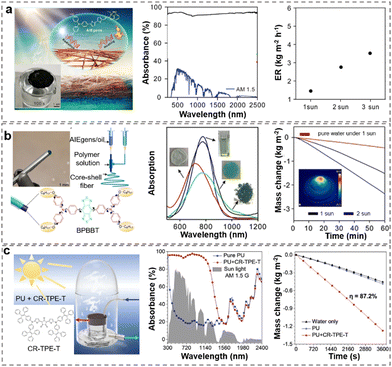 | ||
| Fig. 6 Solar steam generation by AIEgens. Schematic illustration (left), absorption spectra (middle) and water evaporation efficiency (right) of (a) full-spectra absorbing fibre doped with AIEgen MTTT-BT, (b) core shell fibre with AIEgen BPBBT inside and (c) polyurea doped with AIEgen CR-TPE-T under solar irradiation. Figures were adapted and reproduced with permission: (a) ref. 39 Copyright 2020, American Chemical Society; (b) ref. 40 Copyright 2020, Wiley-VCH; (c) ref. 41 Copyright 2020, Wiley-VCH. | ||
To further utilize the molecular motion of AIEgens in the solution state to generate heat, they reported an ingenious and universal protocol.47 This was a core–shell nanofibers that contained AIEgen BPBBT (14) in olive oil solution surrounded by a PVDF-HFP shell. BPBBT was well dissolved in olive oil, leading to reduced fluorescence and increased photothermal conversion. Under solar irradiation of 1 Sun, the temperature of BPBBT/PVDF-HFP nanofiber increased to 40.4 °C, while the temperature reached 56.18 °C in core–shell nanofiber. And the evaporation rate of the core–shell nanofiber was 1.52 and 2.42 kg m−2 h−1 under the irradiation of 1 and 2 Sun, respectively (Fig. 6b). They also reported a stable croconium derivative named CR-TPE-T (15) for solar steam generation.48 CR-TPE-T possessed unique biradical properties and strong π–π stacking in the solid state. It showed a broad absorption spectrum between 300 and 1600 nm. In the meantime, the photothermal efficiency was 72.7% under 808 nm laser irradiation. A composite of CR-TPE-T-loading polyurea (PU) foam was fabricated to establish an interfacial-heating evaporation system. The solar energy to vapor efficiency and water evaporation rate were 87.2% and 1.272 kg m−2 h−1 under irradiation of intensity equal to 1 Sun, respectively (Fig. 6c).
Conclusions and perspectives
The efficient photoluminescence in the aggregate state as well as photothermal conversion in the solution state of AIEgens have been utilized in LSCs, photosynthesis augmentation and solar steam generation. The high quantum yield of AIEgens in the aggregate state is efficient in photon collection in LSCs. Thus doping AIEgens in the optical polymers shows high optical efficiency. The homogeneity of AIEgens within the polymer matrix was further improved by incorporation of AIE polymers. Although AIEgens usually showed a large Stokes shift, there was still energy loss in reabsorption. Utilizing two or more AIEgens with matched energy transfer largely reduced the reabsorption and increased the optical efficiency. Alternatively, constructing tandem LSCs of several slabs with distinctive absorption spectra also increased the energy usage. In the application of BIPV, the balance of lighting and electricity generation needs to be taken, from the aspect of intensity and spectra. This means that the best absorption of AIEgens should be in the invisible region to keep the normal lighting. Therefore, the AIEgens that mainly absorb in the UV region while emitting in the red region or even near infrared region will be favored.Efficient spectral shift from the UV to the visible range and blue/green to yellow/red augmented the photosynthesis of chloroplasts and microalgae due to the spectral preference of photosynthetic pigments. The spectral shift could function inside chloroplasts by internalization, on the surface of chloroplasts by click reaction, around microalgae as suspension and on the covering between the container and the light source. Shortening the distance between AIEgens with photosynthetic units endowed better light usage and dramatic augmentation, while being disturbed by the separation and reuse of AIEgens. Shifting layers outside the culture system is easy to perform and reuse, while facing the problem of inevitable photon loss because of the isotropic nature of fluorescence. On the other hand, the investigation referring to augmentation in higher plants is beneficial for the broader and deeper influence on the forest and farmland.
The photothermal conversion of AIEgens in solution state was utilized for solar steam generation. Doping AIEgens in fibers with a 3D structure largely increased the light collection in the whole solar spectra, which efficiently converted photon energy into heat. The vaporizing process was further boosted by the floating and self-pumping effect of the structure. The photothermal conversion was further modulated by molecular design and solution/aggregate state adjustment. However, the performances of appropriate AIEgens in seawater systems, especially on the large scale and long-term still need more systematic research in future.
Taken together, AIEgens possessed unique advantages in solar energy utilization, and some emerging reports in LSCs, photosynthesis augmentation and solar steam generation open the gates. However, some more interdisciplinary applications, detailed investigations and standard evaluations call for joint efforts for further development.
Author contributions
H. Liu contribute to the conception of the work. H. Bai, J. W. Y. Lam and R. T. K. Kwok contribute to the discussion of the work. Prof. B. Z. Tang supervised the project. The manuscript was written through contributions of all authors. All authors have given approval to the final version of the manuscript.Conflicts of interest
There are no conflicts to declare.Acknowledgements
This work is supported by the Innovation and Technology Commission (ITC-CNERC14SC01), the Research Grants Council of Hong Kong (16306620 and 16303221), and the Science and Technology Plan of Shenzhen (JCYJ20200109110608167, JCYJ201805807183832744, and JCYJ20180306180231853).Notes and references
- J. P. Dorian, H. T. Franssen and D. R. Simbeck, Energy Policy, 2006, 34, 1984–1991 CrossRef.
- N. S. Lewis, Science, 2016, 351, aad1920 CrossRef PubMed.
- J. Day, S. Senthilarasu and T. K. Mallick, Renewable Energy, 2019, 132, 186–205 CrossRef.
- P. G. Stephenson, C. M. Moore, M. J. Terry, M. V. Zubkov and T. S. Bibby, Trends Biotechnol., 2011, 29, 615–623 CrossRef CAS PubMed.
- T. P. Ding, Y. Zhou, W. L. Ong and G. W. Ho, Mater. Today, 2021, 42, 178–191 CrossRef CAS.
- M. D. Ooms, C. T. Dinh, E. H. Sargent and D. Sinton, Nat. Commun., 2016, 7, 1–13 Search PubMed.
- W. G. Van Sark, K. W. Barnham, L. H. Slooff, A. J. Chatten, A. Büchtemann, A. Meyer, S. J. McCormack, R. Koole, D. J. Farrell and R. Bose, Opt. Express, 2008, 16, 21773–21792 CrossRef CAS PubMed.
- H. Liu, N. Yan, H. Bai, R. T. Kwok and B. Z. Tang, Exploration, 2022, 2, 20210053 CrossRef.
- P. Zhang, Q. Liao, H. Yao, Y. Huang, H. Cheng and L. Qu, Energy Storage Mater., 2019, 18, 429–446 CrossRef.
- J. D. Luo, Z. L. Xie, J. W. Y. Lam, L. Cheng, H. Y. Chen, C. F. Qiu, H. S. Kwok, X. W. Zhan, Y. Q. Liu, D. B. Zhu and B. Z. Tang, Chem. Commun., 2001, 1740–1741 RSC.
- J. Mei, N. L. C. Leung, R. T. K. Kwok, J. W. Y. Lam and B. Z. Tang, Chem. Rev., 2015, 115, 11718–11940 CrossRef CAS PubMed.
- F. Rizzo and F. Cucinotta, Isr. J. Chem., 2018, 58, 874–888 CrossRef CAS.
- R. T. K. Kwok, C. W. T. Leung, J. W. Y. Lam and B. Z. Tang, Chem. Soc. Rev., 2015, 44, 4228–4238 RSC.
- H. Liu, L. H. Xiong, R. T. K. Kwok, X. He, J. W. Y. Lam and B. Z. Tang, Adv. Opt. Mater., 2020, 8, 2000162 CrossRef CAS.
- Y. Cao, W. Chen, H. Sun, D. Wang, P. Chen, A. B. Djurišić, Y. Zhu, B. Tu, X. Guo and B. Z. Tang, Solar RRL, 2020, 4, 1900189 CrossRef CAS.
- S. M. Wagalgave, A. C. Mendhe, D. N. Nadimetla, M. Al Kobaisi, B. R. Sankapal, S. V. Bhosale and S. V. Bhosale, J. Electroanal. Chem., 2021, 895, 115451 CrossRef CAS.
- N. Gu, P. Zhang, L. Song, P. Du, L. Ning, P. Buregeya Ingabire, W. H. Chen, Y. Wang and J. Xiong, Eur. J. Chem., 2022, 28, e202200850 CAS.
- Q. Wei, N. Fei, A. Islam, T. Lei, L. Hong, R. Peng, X. Fan, L. Chen, P. Gao and Z. J. A. O. M. Ge, Adv. Opt. Mater., 2018, 6, 1800512 CrossRef.
- D. Ding, K. Li, B. Liu and B. Z. Tang, Acc. Chem. Res., 2013, 46, 2441–2453 CrossRef CAS PubMed.
- X. Cai and B. Liu, Angew. Chem., Int. Ed., 2020, 59, 9868–9886 CrossRef CAS PubMed.
- M. Kang, Z. Zhang, N. Song, M. Li, P. Sun, X. Chen, D. Wang and B. Z. Tang, Aggregate, 2020, 1, 80–106 CrossRef.
- M. Yu, R. Huang, J. Guo, Z. Zhao and B. Z. Tang, PhotoniX, 2020, 1, 1–33 CrossRef.
- R. Reisfeld and C. K. Jørgensen, Sol. Energy Mater., 1982, 1–36 Search PubMed.
- I. Papakonstantinou, M. Portnoi and M. G. Debije, Adv. Energy Mater., 2021, 11, 2002883 CrossRef CAS.
- M. G. Debije and P. P. C. Verbunt, Adv. Energy Mater., 2012, 2, 12–35 CrossRef CAS.
- A. Pucci, Isr. J. Chem., 2018, 58, 837–844 CrossRef CAS.
- F. De Nisi, R. Francischello, A. Battisti, A. Panniello, E. Fanizza, M. Striccoli, X. Gu, N. L. C. Leung, B. Z. Tang and A. Pucci, Mater. Chem. Front., 2017, 1, 1406–1412 RSC.
- W. W. Ma, W. J. Li, M. Y. Cao, R. Y. Liu, X. J. Zhao and X. Gong, Org. Electron., 2019, 73, 226–230 CrossRef CAS.
- R. Mori, G. Iasilli, M. Lessi, A. B. Munoz-Garcia, M. Pavone, F. Bellina and A. Pucci, Polym. Chem., 2018, 9, 1168–1177 RSC.
- B. L. Zhang, J. L. Banal, D. J. Jones, B. Z. Tang, K. P. Ghiggino and W. W. H. Wong, Mater. Chem. Front., 2018, 2, 615–619 RSC.
- W. W. Ma, W. J. Li, R. Y. Liu, M. Y. Cao, X. J. Zhao and X. Gong, Chem. Commun., 2019, 55, 7486–7489 RSC.
- X. Zhou, Y. Zeng, F. Lv, H. Bai and S. Wang, Acc. Chem. Res., 2021, 55, 156–170 CrossRef PubMed.
- J. P. Giraldo, M. P. Landry, S. M. Faltermeier, T. P. McNicholas, N. M. Iverson, A. A. Boghossian, N. F. Reuel, A. J. Hilmer, F. Sen, J. A. Brew and M. S. Strano, Nat. Mater., 2014, 13, 400–408 CrossRef CAS PubMed.
- J. Barber, Chem. Soc. Rev., 2009, 38, 185–196 RSC.
- P. S. C. Schulze, L. A. Barreira, H. G. C. Pereira, J. A. Perales and J. C. S. Varela, Trends Biotechnol., 2014, 32, 423–431 CrossRef PubMed.
- M. Y. Jiang, Y. Yuan, Y. C. Fang, S. X. Liu, J. Li, Z. J. Chen, Q. Y. Pang and S. J. Li, J. Mater. Chem. A, 2021, 9, 24308–24314 RSC.
- D. N. Li, W. Li, H. R. Zhang, X. J. Zhang, J. L. Zhuang, Y. L. Liu, C. F. Hu and B. F. Lei, ACS Appl. Mater. Interfaces, 2020, 12, 21009–21019 CrossRef CAS PubMed.
- D. M. Xiao, M. Y. Jiang, X. F. Luo, S. X. Liu, J. Li, Z. J. Chen and S. J. Li, ACS Sustainable Chem. Eng., 2021, 9, 4139–4145 CrossRef CAS.
- H. T. Bai, H. X. Liu, X. Chen, R. Hu, M. Li, W. He, J. Du, Z. Y. Liu, A. J. Qin, J. W. Y. Lam, R. T. K. Kwok and B. Z. Tang, Mater. Horiz., 2021, 8, 1433–1438 RSC.
- S. Singh, B. N. Kate and U. C. Banerjee, Crit. Rev. Biotechnol., 2005, 25, 73–95 CrossRef CAS PubMed.
- B. Sajjadi, W. Y. Chen, A. A. A. Raman and S. Ibrahim, Renewable Sustainable Energy Rev., 2018, 97, 200–232 CrossRef CAS.
- H. X. Liu, H. T. Bai, N. Yan, T. Y. Wong, D. F. Dang, J. S. Ni, J. W. Y. Lam, H. Lam, R. T. K. Kwok, W. X. Wang and B. Z. Tang, ACS Sustainable Chem. Eng., 2021, 9, 15258–15266 CrossRef CAS.
- T. G. Hwang, G. Y. Kim, J. I. Han, S. Kim and J. P. Kim, ACS Sustainable Chem. Eng., 2020, 8, 15888–15897 CrossRef CAS.
- H. Ghasemi, G. Ni, A. M. Marconnet, J. Loomis, S. Yerci, N. Miljkovic and G. Chen, Nat. Commun., 2014, 5, 1–7 Search PubMed.
- H. X. Li, W. Zhu, M. Li, Y. Li, R. T. K. Kwok, J. W. Y. Lam, L. Wang, D. Wang and B. Z. Tang, Adv. Mater., 2021, 33, 2102258 CrossRef CAS PubMed.
- H. X. Li, H. F. Wen, J. Li, J. C. Huang, D. Wang and B. Z. Tang, ACS Appl. Mater. Interfaces, 2020, 12, 26033–26040 CrossRef CAS PubMed.
- H. X. Li, H. F. Wen, Z. J. Zhang, N. Song, R. T. K. Kwok, J. W. Y. Lam, L. Wang, D. Wang and B. Z. Tang, Angew. Chem., Int. Ed., 2020, 59, 20371–20375 CrossRef CAS PubMed.
- G. Y. Chen, J. M. Sun, Q. Peng, Q. Sun, G. Wang, Y. J. Cai, X. G. Gu, Z. G. Shuai and B. Z. Tang, Adv. Mater., 2020, 32, 1908537 CrossRef CAS PubMed.
| This journal is © The Royal Society of Chemistry 2023 |
